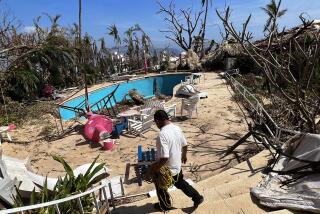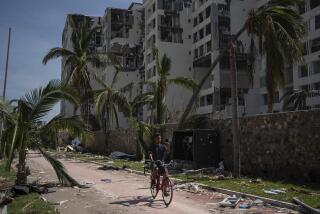Fury of Charley shocks Floridians
The death toll from Hurricane Charley rose to at least 16 as millions of Floridians in a 200-mile stretch from the Gulf Coast to the Atlantic Ocean struggled to put their homes and lives back together.
At daybreak, many stunned survivors of Charley’s wrath got their first look at the damage and began adjusting to the prospect of days without electricity, water, phones and television. Trees were felled; roofs were ripped off homes, schools and businesses; buildings crumbled; traffic lights were downed; and utility poles tumbled.
In Central Florida, an estimated 1.5 million people remained without power, and utility officials said it may be a week before everybody gets lights back on. Statewide, an estimated 2 million customers had no electricity.
Orange County public schools will remain closed Monday and Tuesday, but Lake County schools will resume. Other area school districts will decide today whether to reopen Monday.
Charley was the most devastating storm since Hurricane Andrew in 1992 to hit the state, and damage was estimated to be in the billions.
“Our worst fears have come true,” Gov. Jeb Bush said after a helicopter tour of devastated Southwest Florida.
His brother, President Bush, today will tour Charlotte County, the hardest-hit area. He has declared 20 counties, including all of Central Florida except Brevard, a disaster area, opening the way for federal aid.
In Tallahassee, Sam Miller, vice president of the Florida Insurance Council, predicted Charley would be the most expensive storm since Andrew, which inflicted $20 billion to $35 billion in damage, according to various estimates adjusted for inflation, as the costliest natural disaster in U.S. history.
The cleanup is proving costly for residents who are paying for gas-powered generators, tree removal and other hurricane-recovery essentials, and within hours the state Attorney General’s Office had received more than 100 complaints about price gouging.
The state’s emergency-response team was deploying more than 1.8 million gallons of bottled water and 2.9 million pounds of ice to damaged areas. The Southwest Florida cities of Arcadia, Port Charlotte and Punta Gorda were without water service and would need to use boiled water, state environmental officials said.
The state asked FEMA for temporary housing for 10,000 people -- probably through a combination of vacant apartments and travel trailers and mobile homes brought from other parts of the state or elsewhere.
About 1,500 Florida National Guard members have been activated, and an additional 5,000 were being called up.
Storm-ravaged Punta Gorda enacted a 7:30 p.m.-to-7:30 a.m. curfew, and some looting was reported in Charlotte County, where thieves broke into the county’s fire headquarters and stole computers, said Wayne Sallade, Charlotte County’s director of emergency management.
Sallade said he had confirmed 10 deaths in the county, but an exact total was not available. “Not hundreds. I would hope that it would be limited to dozens, if that,” Sallade said.
In the morning, Charlotte County deputies were standing guard over bodies because the area was inaccessible to ambulances.
Hundreds of people were still missing in Charlotte, and thousands were left homeless, Sallade said. He compared the devastation to that of Hurricane Andrew, which the National Hurricane Center directly blamed for the deaths of 26 people.
“It’s Andrew all over again,” he said. “We believe there’s significant loss of life.”
State officials confirmed 13 deaths based on reports from county medical examiners. The state listed four deaths in Charlotte, two deaths apiece in Orange, Polk and Volusia counties, and one death apiece in DeSoto, Lee and Sarasota counties. But Orange and municipal officials said they had no knowledge of a second death.
Charlotte Sheriff’s Office spokesman Bob Carpenter said Saturday that 31 mobile-home parks in the county suffered major damage, and teams were being sent to every one of them to search for victims and survivors.
Elsewhere along the Gulf Coast, Charley sliced in half North Captiva Island.
“Now it’s two islands,” said Al Heoo, head of damage assessment for Sanibel Island.
Sanibel, known for its seashell-laden beaches, also had major damage, Heoo said, but the impassability of the only causeway to the island has prevented a comprehensive assessment. More than 100 people reportedly rode out the storm on the island.
In Port Charlotte, Jim O’Connor survived a night of Charley’s beating on his door by huddling in his bathtub, clutching his Scottish terrier, Angus. Outside, the storm’s 145-mph winds shredded his neighbor’s newly remodeled home. Inside the tub, O’Connor crouched in terror.
“I was just hoping for the best, but it was awful,” he said.
When it was over, O’Connor, a real-estate agent, found his living-room wall splattered with mud shot through broken windows. A U-Haul trailer had been tossed in his front yard.
Next door, his neighbor’s house had outside walls still standing, but the roof was gone, the interior walls were crushed and furniture smashed. The family that owned the home left before Charley arrived.
“They would have been killed if they’d been in there,” O’Connor said.
In addition to the fatalities in Charlotte County, a woman in Daytona Beach died of apparent electrocution, police said. Her body was found early Saturday at the base of a power pole in a residential area. A downed power line was touching her foot.
A Lake Wales man died after his Chevrolet truck drove into a washed-out section of road and flipped, sending the vehicle about 35 feet down an embankment, Polk County sheriff’s spokeswoman Michal Shanley said.
Two others died in storm-related traffic accidents -- one in Orange County -- and a Fort Myers man was killed by a falling tree. Earlier, the storm killed three people in Cuba and one in Jamaica.
As the search for victims and survivors continued in Southwest Florida, the federal government announced it was sending a 25-member mortuary team to help process bodies. Cadaver dogs were being used to search for bodies in the rubble.
Three Charlotte County hospitals sustained significant damage, and officials at Charlotte Regional Medical Center in Punta Gorda said they had to evacuate all patients Saturday.
More than 200 ambulances were organized to transfer patients to other hospitals in Orlando, Sarasota, Tampa and Lee County. Ambulances and fire-rescue trucks formed a parade in front of the hospital, loading up patients before taking off.
Among those seeking treatment at Charlotte Regional was Marty Rietveld, showered with broken glass when the sliding-glass door at his home was smashed by a neighbor’s flying roof. Rietveld broke his leg, and his future son-in-law suffered a punctured leg artery.
“We are moving,” said Rietveld’s daughter, Stephanie Rioux. “We are going out of state.”
Charley caused widespread damage through the midsection of Florida before clobbering the Carolinas with winds up to 85 mph and as much as 6 inches of rain.
When Charley hit Florida on Friday, the eye of the hurricane passed directly over Punta Gorda, a town of 15,000 that was ranked a year ago as the nation’s fourth-best place to live.
Not now.
In the Port Charlotte neighborhoods just off of U.S. Highway 41, dozens of homes and businesses had been blown apart. Others had their roofs ripped off like pop tops. An airboat, made airborne by Charley, landed on top of a garage. The canals running through the neighborhoods -- littered with furniture, roof beams, storage sheds and other debris -- looked more like city dumps.
Charley took no pity on Charlotte County but spared the Tampa Bay area, where about a million people had been told to leave their homes. Some drove east, only to find themselves in the path of the storm.
“I feel like the biggest fool,” said Robert Angel of Tarpon Springs, who sought safety in a motel. “I spent hundreds of dollars to be in the center of a hurricane.”
But when Angel returns to Tarpon Springs, he shouldn’t get too comfortable. Two other tropical cyclones are brewing.
Danielle, gaining strength in the eastern Atlantic, was updated to a hurricane late Saturday. Tropical Storm Earl, predicted to reach hurricane strength by Monday, is on a similar track to that taken by Charley.
Bob Mahlburg, Jason Garcia, Gwyneth Shaw and Keith Kohn of the Sentinel staff contributed to this report. Wire services also were used. Jeff Kunerth can be reached at jkunerth@orlandosentinel.com or 407-420-5392. Jim Stratton can be reached at jstratton@orlandosentinel.com or 407-420-5379.
More to Read
Start your day right
Sign up for Essential California for news, features and recommendations from the L.A. Times and beyond in your inbox six days a week.
You may occasionally receive promotional content from the Los Angeles Times.






